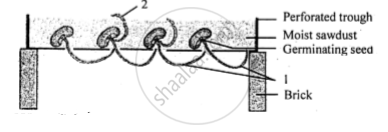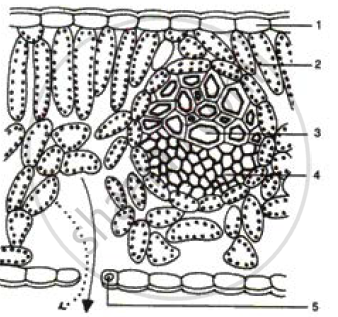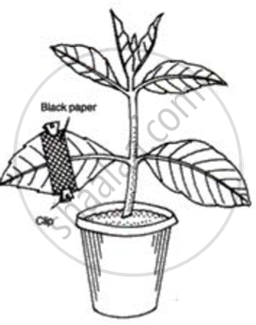Advertisements
Advertisements
प्रश्न
How does carbon dioxide return to the atmosphere? Explain.
A student in order to study the importance of certain factors of photosynthesis took a potted plant and kept it in the dark for over 24 hours. Then in the early hours of the morning the student covered one of the leaves with black paper in the centre only. Student placed the potted plant in the sunlight for a few hours, and then tested the leaf which was covered with black paper for starch.
(i) What aspect of photosynthesis was being investigated?
(ii) Is there any control in this experiment? If so, state the name.
(iii) Why was the plant kept in the dark before the experiment?
(iv) Describe step by step how the candidate proceeded to test the leaf for the presence of starch.
उत्तर
(a) Carbon dioxide is returned back to the atmosphere mainly through the following ways:
(i) Respiration - Animals and plants respire and release carbon dioxide in the atmosphere.
(ii) Decay - Plants and animals decay organic matter with the help of bacteria and fungi and release carbon dioxide.
(iii) Combustion - Plants and animals which got buried under the soil changed into coal and oil and releases carbon dioxide when these are burnt.
(iv) Ocean water - Carbon dioxide occurs in the form of lime stone in molluscan shells and as by product of photosynthesis in marine water.
(b) (i) To show that sunlight is needed for photosynthesis.
(ii) Yes, the uncovered portion of the experimental leaf is the control.
(iii) To destarch the leaf.
(iv) 1. Boil the leaf in alcohol.
2. Wash the leaf in water to make it soft.
3. Add iodine solution on the leaf. The portion uncovered shows blue-black colour and the portion covered shows brown colour. This indicates that sunlight is needed for photosynthesis.
APPEARS IN
संबंधित प्रश्न
The individual flattened stacks of membranous structures inside the chloroplasts are known as :
A. Grana
B. Stroma
C. Thylakoids
D. Cristae
Expand the following biological abbreviations: ATP
Given below is an experiment setup to demonstrate a particualr tropic movement in germinating seeds. Study the diagram and answer the questions that follow : 
What is Thigmotropism? Give one example.
Define the following:
Plant pigments
The figure given below represents the vertical section of a leaf.
( i) Name the parts labeled 1 to 5.
( ii ) What do the two arrows (dotted and solid) indicate in the daytime and at night?
( iii) Could you add one more arrow in the figure? If yes, what for?
( iv) How many leaf veins have been shown in this section?

Name the following:
The products that are formed as a result of photosynthesis.
Name the following:
Three organisms that cannot prepare their own food by photosynthesis.
Complete the following by filling in the blanks numbered 1 to 10 with the appropriate word/term:
Photosynthesis involves light reaction and dark reaction. During light reaction, the chlorophyll present in the (1) ______ gets activated by absorbing light energy. This energy splits (2) ______ molecules to (3) ______ and oxygen and releases two electrons. This process is called (4) ______. The (5) ______ ions are picked up by NADP to form (6) ______. The ADP is converted to (7) ______. This process is called (8) ______. During the dark phase, the compound produced at the end of the light reaction reacts with carbon dioxide to form (9) ______. This product is converted to starch. The process is called (10) ______.
The diagram alongside represents an experiment conducted to prove the importance of a factor in photosynthesis.

Study the same and then answer the questions that follow:
(i) Name the factor being studied in his experiment.
(ii) Why was the plant kept in a dark room before conducting the experiment?
(iii}Why was the experimental leaf then kept in
1. boiling water 2. methylated spirit?
(iv) Name the solution used to test for the presence of starch in the leaf.
(v) What will we observe in the experimental leaf at the end of the starch test?
(vi) Give a balanced chemical equation to represent the process of photosynthesis.
Choose the correct answer:
Which one of the following is the best reason for leaving a plant in a dark place before carrying out experiments on photosynthesis?
The figure given below is for performing an experiment on photosynthesis.

Answer the following:
(i) What is the aim of this experiment?
(ii) Describe an experiment to show that light is necessary for photosynthesis.
(iii) What do you conclude from this experiment?
(iv) What is the role of light in photosynthesis?
Explain the Term NADPH.
Explain the term Plastoquinone.
Give technical term:
What does NADP stand for?
Choose the Correct Answer:
NADP is expanded as
Oxygen is used for the synthesis of protein and fertilizers.
Sunflowers open the petals in bright light during the daytime but close the petals in dark at night. This response of sunflowers is called ______.
Plants may inhale carbon dioxide for photosynthesis but need ______ for their living.
Define photosynthesis.
